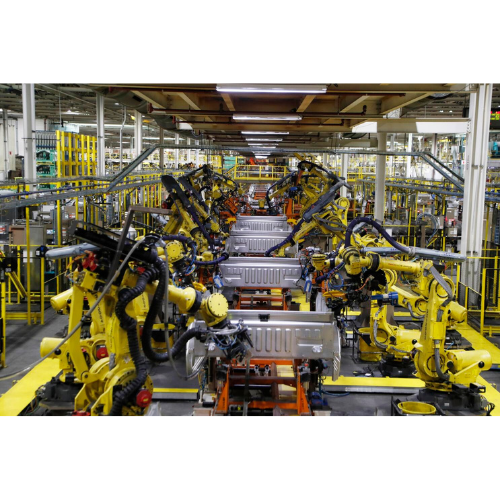The Current State of the U.S. Automotive Industry
The U.S. automotive industry is undergoing a transformative shift driven by electrification, labor dynamics, global trade tensions, and regional manufacturing realignments.
Industry Overview: A Sector in Transition
The automotive industry in the United States remains a cornerstone of the national economy, employing nearly 1 million workers and generating billions in revenue annually. However, the sector is facing a period of contraction and reinvention. According to the Bureau of Labor Statistics, U.S. auto manufacturing employed approximately 997,300 workers in April 2025—a decline of 20,800 jobs compared to the previous year.
This drop is largely attributed to the shift away from internal combustion engine (ICE) vehicles and the rise of electric vehicles (EVs), which require fewer parts and different manufacturing processes. Parts manufacturing, in particular, has been hit hard, with a loss of over 19,000 jobs year-over-year.
The Rise of Electric Vehicles (EVs)
Electrification is the most significant trend reshaping the U.S. automotive industry. Major automakers like Ford, General Motors, and Stellantis have invested over $87 billion in EV and battery manufacturing facilities across the country. These investments are redefining supply chains and regional manufacturing hubs.
Southern states such as Alabama and Kentucky are emerging as key players in EV production. Mercedes-Benz, for example, announced plans to produce a new core-segment EV at its Tuscaloosa, Alabama plant starting in 2027. These moves reflect a broader strategy to localize production and reduce exposure to global supply chain disruptions.
Labor Market Shifts and Wage Growth

While job losses have been notable, wages in the auto manufacturing sector are on the rise. In April 2025, average hourly pay increased by $2.52 to reach $32.81, driven by union contracts and the growing demand for skilled labor in EV and battery production. This wage growth signals a shift toward higher-value manufacturing roles and a more competitive labor market.
However, the benefits are unevenly distributed. Legacy manufacturing states like California, Indiana, and Ohio are experiencing job losses due to high production costs and declining demand for ICE components. In contrast, Southern states are attracting new investments and expanding their workforce.
Global Trade and Export Challenges
The U.S. automotive industry is also grappling with global trade dynamics. Over the past decade, the country exported $1.2 trillion worth of vehicles and parts—more than any other manufacturing sector. Yet, barriers to market access in regions like Asia, Latin America, and the Middle East continue to hinder growth.
Non-tariff barriers, such as the non-acceptance of U.S. safety and environmental standards, pose significant challenges for American automakers. Policymakers are being urged to negotiate better trade terms to ensure that U.S.-made vehicles can compete globally on a level playing field.
Innovation and R&D Investment
Innovation remains a driving force behind the industry’s evolution. Automakers are investing heavily in research and development, particularly in autonomous vehicle (AV) technologies and advanced battery systems. These investments positioning the U.S. as a leader in future mobility solutions.
Ford, GM, and Stellantis continue to lead in domestic R&D spending, conducting more research in the U.S. than their foreign competitors. This focus on innovation is critical for maintaining global competitiveness and adapting to rapidly changing consumer preferences.
Regional Manufacturing Realignment
The geographic distribution of automotive manufacturing in the U.S. is shifting. High-cost regions in the North are losing ground to more business-friendly Southern states. For example:
California lost 7,100 vehicle manufacturing jobs in the past year.
Alabama gained 400 jobs, bringing its total to 23,000.
Kentucky added 200 jobs, now totaling 24,400.
This realignment is driven by factors such as lower labor costs, favorable tax policies, and proximity to new EV and battery plants. Southern states are becoming the new epicenters of automotive innovation and production.
Market Trends and Consumer Demand
Consumer demand is also evolving. While overall vehicle sales have rebounded from pandemic lows, the mix is shifting toward EVs and SUVs. Light vehicle sales reached approximately 14.5 million units in early 2025, with SUVs and light trucks accounting for a growing share.
Imported vehicles, particularly from China and Mexico, are gaining market share, reflecting changing consumer preferences and competitive pricing. U.S.-based automakers are responding by expanding their EV offerings and optimizing production to meet new demand patterns.
Challenges Ahead
Despite the progress, the U.S. automotive industry faces several challenges:
Supply Chain Disruptions: Ongoing issues with semiconductor availability and raw material sourcing continue to impact production timelines.
Regulatory Uncertainty: Shifting environmental and safety regulations create compliance challenges for automakers.
Global Competition: Foreign automakers are aggressively expanding their presence in the U.S. market, increasing competitive pressure.
Opportunities for Growth
Looking ahead, the industry has several avenues for growth:
EV Expansion: Continued investment in EV infrastructure and consumer incentives will drive adoption.
Export Strategy: Improved trade agreements and standard harmonization can unlock new markets.
Workforce Development: Upskilling programs and partnerships with technical schools can address labor shortages and prepare workers for future roles.
